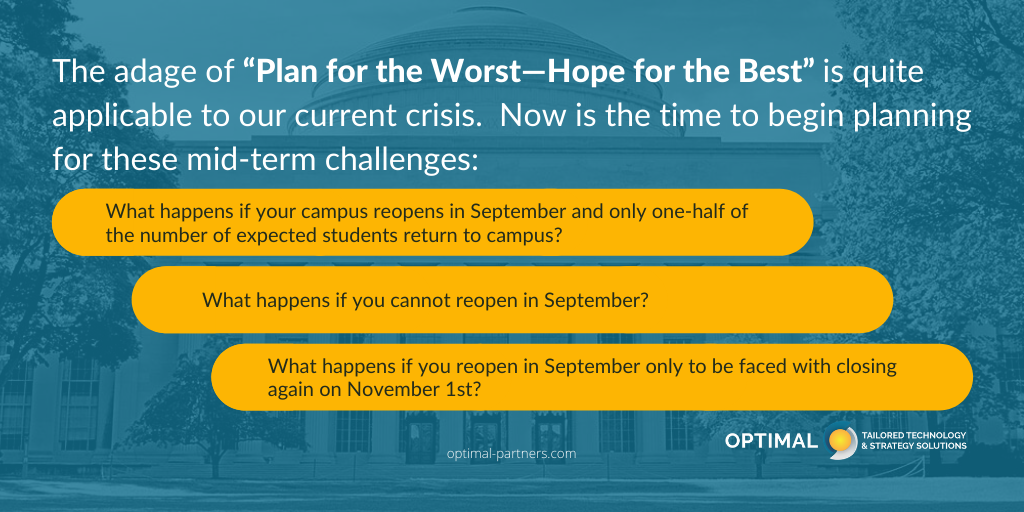 The current global public health crisis is creating huge challenges for higher education. Colleges and universities across the globe are closing on-campus activities. Classes–and day-to-day business–are moving online. Higher education institutions are scrambling to deal with the day-to-day operational issues of the crisis, and these are, no doubt, huge. In a conversation last week, a higher ed official in the Western United States revealed that his school had modeled being able to support 100,000 simultaneous Zoom connections as a part of their move to 100% online education. One of us recently attended a Zoom board meeting for a European university. This school is dealing with the expectation of a shelter-in-place order in the near future. Since the university has hundreds of students who could not be sent home (they are 95% international and a significant proportion of their student body is from China), this is straining their housing and foodservice operations. Shelter-in-place may not be realistic in the case of a tiny dorm room that can barely accommodate two students. As a result, they are looking for apartments to rent to deal with these demands. Across the globe, faculty who have never before taught online are having to move their courses to a fully online environment in a matter of weeks, or even days. Schools are buying laptops, developing training programs to assist faculty members to transition their courses into online formats, and even sending IT technicians to homes to optimize WIFI systems for online teaching. The challenges are gigantic, but individuals and institutions seem to be rising to the occasion.
The current global public health crisis is creating huge challenges for higher education. Colleges and universities across the globe are closing on-campus activities. Classes–and day-to-day business–are moving online. Higher education institutions are scrambling to deal with the day-to-day operational issues of the crisis, and these are, no doubt, huge. In a conversation last week, a higher ed official in the Western United States revealed that his school had modeled being able to support 100,000 simultaneous Zoom connections as a part of their move to 100% online education. One of us recently attended a Zoom board meeting for a European university. This school is dealing with the expectation of a shelter-in-place order in the near future. Since the university has hundreds of students who could not be sent home (they are 95% international and a significant proportion of their student body is from China), this is straining their housing and foodservice operations. Shelter-in-place may not be realistic in the case of a tiny dorm room that can barely accommodate two students. As a result, they are looking for apartments to rent to deal with these demands. Across the globe, faculty who have never before taught online are having to move their courses to a fully online environment in a matter of weeks, or even days. Schools are buying laptops, developing training programs to assist faculty members to transition their courses into online formats, and even sending IT technicians to homes to optimize WIFI systems for online teaching. The challenges are gigantic, but individuals and institutions seem to be rising to the occasion.
What Does the Future Hold?
As challenging as these immediate issues are, the future likely holds even larger challenges. A recent paper from the UK modeling the spread of the virus concluded that strategies such as the closing of schools will be necessary until a vaccine is available—perhaps 18 to 24 months. This crisis is not going to abate quickly for universities.

The mid-term (the next 18-24 months) will not mark the end of the challenges we will be facing. When we look back, we will likely say that the COVID-19 pandemic did more to change the face and nature of higher education than anything else in the past millennium. The move to a largely online environment has been extremely swift and it is not likely to be completely reversed. Students who are working professionals (i.e., many of our graduate students as well as some undergraduates), as well as millennials, have been saying that they prefer online education, but we have been slow to respond, often due to faculty resistance. There are many schools that have eschewed online strategies because they felt they did not fit the culture of their school. Faculty at these institutions are often starting from scratch in developing online strategies to finish out the spring semester. In the future, we will have no excuses for not offering our programs in a wide and varied pedagogical environment. We will need to get very good at it, to make the online and blended experiences as rich as a typical on-campus experience. And that is what will be demanded. How will this impact our need for physical facilities, for staff, for faculty? It will certainly impact the technology infrastructure each institution requires. But what will this all cost?
Moody’s Investors Service recently downgraded the outlook for higher education from stable to negative. Borrowing costs are going to rise, the value of investments has declined, and certain operating costs will rise dramatically (IT is a good example). These challenges will push schools that are currently at financial risk into insolvency. They will certainly tax the viability of all but the most heavily endowed institutions. The time to begin thinking about the radically changed future environment and to develop strategies to survive in it is now.
Planning for an Uncertain Future
How does a university go about planning in the face of such a dire situation and such monumental uncertainty? Uncertain times demand planning–they do not let us “off the hook.” Teams including senior administration and faculty leadership should be conducting exercises to simulate how they would respond to various scenarios, including the worst cases. These are the types of very real questions that can be addressed through simulations, and, through such simulations, effective responses can be developed. These teams need to be looking at the crisis from a systems perspective, understanding how changes in one area affect others, and searching to find the unintended consequences that are inevitable whenever dramatic changes are made. Data will be critical to effective planning and decision making. Schools need to make sure their IT and institutional research functions are staffed to provide decision-makers with this data.
Over the course of the next few weeks and months, we at Optimal Campus will continue to outline strategies for dealing with the mid-term and long-term implications of the Coronavirus crisis and our changing higher education environment. Watch this site for regular blogs about these strategies. Let us know what questions and challenges you have about the future either by leaving a comment below or by contacting our principal consultants directly.
Our next blog will focus on the nature of the higher education crisis:
Avoid costly mistakes and wasted time – talk to an impartial peer in Higher Ed!
There is nothing like speaking with a peer who has implemented the same product – send us a request.
You can also provide general feedback, inquire about additional free resources, submit a topic you’d like us to cover, tell us about a feature you’d like to see, or request the best staff for your project.